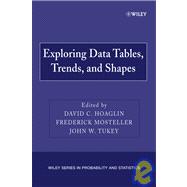
What is included with this book?
FREDERICK MOSTELLER, PhD, has been the recipient of several honorary degrees and is a former President of the American Statistical Association.
JOHN W. TUKEY, PhD, has received the National Medal of Science as well as several honorary degrees.
|
1 | (36) | |||
|
|||||
|
4 | (5) | |||
|
9 | (3) | |||
|
12 | (10) | |||
|
22 | (7) | |||
|
29 | (2) | |||
|
31 | (6) | |||
|
37 | (30) | |||
|
|||||
|
37 | (2) | |||
|
39 | (8) | |||
|
47 | (2) | |||
|
49 | (12) | |||
|
61 | (6) | |||
|
62 | (5) | |||
|
67 | (58) | |||
|
|||||
|
|||||
|
68 | (3) | |||
|
71 | (8) | |||
|
79 | (4) | |||
|
83 | (9) | |||
|
92 | (8) | |||
|
100 | (13) | |||
|
113 | (4) | |||
|
117 | (8) | |||
|
119 | (6) | |||
|
125 | (64) | |||
|
|||||
|
126 | (2) | |||
|
128 | (2) | |||
|
130 | (15) | |||
|
145 | (13) | |||
|
158 | (6) | |||
|
164 | (12) | |||
|
176 | (4) | |||
|
180 | (2) | |||
|
182 | (1) | |||
|
183 | (6) | |||
|
185 | (4) | |||
|
189 | (36) | |||
|
|||||
|
|||||
|
192 | (3) | |||
|
195 | (4) | |||
|
199 | (7) | |||
|
206 | (6) | |||
|
212 | (2) | |||
|
214 | (3) | |||
|
217 | (4) | |||
|
221 | (2) | |||
|
223 | (2) | |||
|
225 | (16) | |||
|
|||||
|
|||||
|
|||||
|
|||||
|
226 | (3) | |||
|
229 | (9) | |||
|
238 | (3) | |||
|
241 | (40) | |||
|
|||||
|
|||||
|
242 | (4) | |||
|
246 | (4) | |||
|
250 | (13) | |||
|
263 | (10) | |||
|
273 | (8) | |||
|
275 | (6) | |||
|
281 | (64) | |||
|
|||||
|
282 | (9) | |||
|
291 | (13) | |||
|
304 | (6) | |||
|
310 | (12) | |||
|
322 | (6) | |||
|
328 | (7) | |||
|
335 | (10) | |||
|
341 | (4) | |||
|
345 | (72) | |||
|
|||||
|
|||||
|
348 | (10) | |||
|
358 | (12) | |||
|
370 | (6) | |||
|
376 | (13) | |||
|
389 | (7) | |||
|
396 | (10) | |||
|
406 | (3) | |||
|
409 | (8) | |||
|
412 | (5) | |||
|
417 | (44) | |||
|
|||||
|
419 | (6) | |||
|
425 | (7) | |||
|
432 | (10) | |||
|
442 | (8) | |||
|
450 | (4) | |||
|
454 | (2) | |||
|
456 | (5) | |||
|
459 | (2) | |||
|
461 | (54) | |||
|
|||||
|
462 | (17) | |||
|
479 | (6) | |||
|
485 | (5) | |||
|
490 | (6) | |||
|
496 | (5) | |||
|
501 | (3) | |||
|
504 | (4) | |||
|
508 | (7) | |||
|
511 | (4) | |||
| Index | 515 |
The New copy of this book will include any supplemental materials advertised. Please check the title of the book to determine if it should include any access cards, study guides, lab manuals, CDs, etc.
The Used, Rental and eBook copies of this book are not guaranteed to include any supplemental materials. Typically, only the book itself is included. This is true even if the title states it includes any access cards, study guides, lab manuals, CDs, etc.